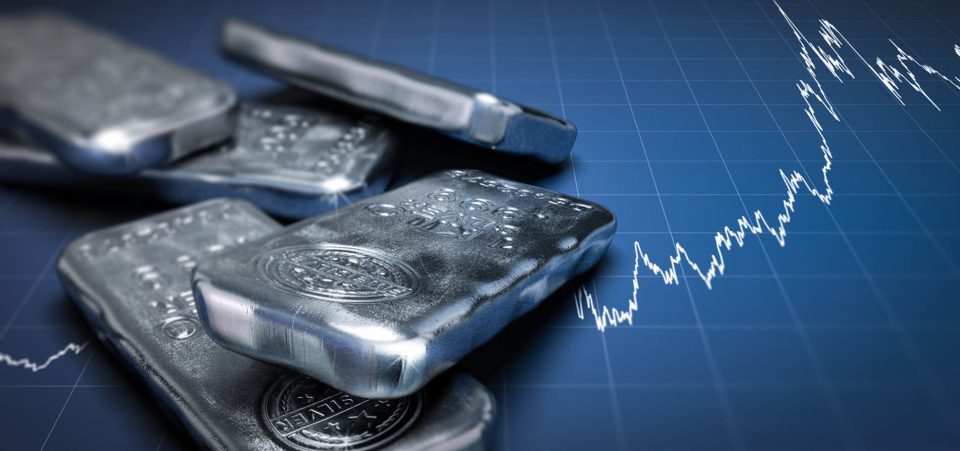Demand and Supply Suggest Silver Prices Could Be Setting Up to Rise
Investors looking for the next big trade shouldn’t ignore silver prices. The gray precious metal could be setting up to jump. It wouldn’t be shocking to see silver prices shoot to their 2011 highs—around $50.00—in matter of a few years.
Let’s get this straight: my silver price outlook is not based on a gut feeling. The very basic fundamentals of the silver market, and several other factors, suggest this could be possible.
Before jumping to any conclusion and buying into the mainstream narrative of precious metal being useless for one’s portfolio, the first thing that investors must pay attention to is the demand and supply in the silver market.
Demand For Silver Soaring Across the World
To get some idea of demand, look at silver sales at mints around the world. Mints are selling huge sums of the gray precious metal. Consider this: in the first three months of 2017, the United States Mint sold close to 8 million ounces of silver in American Eagle coins alone. (Source: “Bullion Sales,” United States Mint, last accessed April 20, 2017.)
At Australia’s Perth Mint, between February and March of this year, there was a severe rush toward silver. Its silver bullion sales in February were 502,353 ounces. In March, the mint reported sales of 716,283 ounces of silver. If you do the simple math, this represents an increase of close to 43% month-over-month! (Source: “Monthly Sales – March 2017,” The Perth Mint, April 6, 2017.)
Institutional Investors Buying Again
Know that those who ditched silver back in 2013 are starting to step back in again. Of course, I am talking about the institutional investors. They sold silver back then because they bought into the idea that higher interest rates would be bad for the precious metal. This caused silver prices to plummet.
If you look at the data now, it seems like institutional investors are coming back big-time.
Look at the most recent “Commitments of Traders” (COT) report released by the U.S. Commodity Futures Trading Commission (CFTC). This report essentially provides a perspective on how the futures market looks on a weekly basis, and what kind of players in the markets are buying or selling.
For the week ending April 11, managed money (institutional investors) were long on 114,249 silver contracts. In the first week of 2017, these same investors were long on 61,676 silver contracts. In other words: they have increased their exposure to silver by 85% in matter of few months. (Source: “Commitments of Traders,” U.S. Commodity Futures Trading Commission, last accessed April 20, 2017.)
Keep in mind, one silver contract is based on 5,000 troy ounces of silver. In simple terms, institutional investors are long on 571.0 million ounces of silver!
Supply in the Silver Market Dwindling
Looking at the basic supply side, it appears that the silver-producing regions are reporting dismal production figures.
One of the places that investors need to pay attention to is Mexico. It is the biggest silver-producing country in the world.
Silver production in Mexico in January 2017 amounted to 377,318 kilograms. In the same period a year ago, it was 400,273 kilograms. This represents a decline of 5.7% year-over year.
Don’t just get fixated on a one-month production figure from Mexico though. Look at the table below; it provides an idea of the big picture. This table shows Mexico’s average monthly production for the year, and the percentage change from previous year.
| Year | Average Monthly Silver Production in Kilograms | Year-Over-Year Percentage Change |
| 2008 | 222,336 | 13.46% |
| 2009 | 224,439 | 0.95% |
| 2010 | 291,623 | 29.93% |
| 2011 | 345,862 | 18.60% |
| 2012 | 374,699 | 8.34% |
| 2013 | 405,077 | 8.11% |
| 2014 | 394,117 | -2.71% |
| 2015 | 413,282 | 4.86% |
| 2016 | 387,465 | -6.25% |
| 2017* | 377,318 | -2.62% |
*Note: 2017 figures are based on the month of January only.
(Source: “Value and volume production of Silver,” Servicio Geológico Mexicano, last accessed April 20, 2017.)
Notice something interesting? Although the monthly average production has increased since 2008, since the precious metal prices came under fire from investors in 2013, silver production in Mexico has been decelerating.
Exploration Spending Slashed Substantially
Looking at an even bigger perspective, know that the crash in silver prices in 2013 and beyond was essentially a blessing in disguise for those who are bullish on the precious metal.
Due to a crash in silver prices, mining companies needed to reduce their expenses in order to remain solvent, so they ended up reducing their exploration budget. It was the easiest thing to control.
Remember, exploration is essentially an investment in future production. If companies are not exploring for the precious metal, how are they going to produce it? This could create a big supply problem in the long run.
For example, take Hecla Mining Company (NYSE:HL), a reputable silver producer in the United States. In 2012, the company reported exploration expenses of $31.82 million. (Source: “2012 Form 10-K,” Hecla Mining Company, last accessed April 20, 2017.)
Fast forward to 2016, Hecla’s exploration expense was just $14.72 million. (Source: “2016 Form 10-K,” Hecla Mining Company, last accessed April 20, 2017.)
So, in matter of four years, exploration at Hecla declined by close to 54%.
Here’s the thing: the goal is not to single out Hecla Mining company. This is to give you an idea of what’s happening in the overall mining sector. There are many companies that are doing—or that have done—similar things to what Hecla has done.
Other Factors to Give Boost to Silver Prices
Don’t forget this: silver is considered a safe-haven precious metal. Investors rush toward it in times of uncertainty. And, as it stands, there’s an abundance of uncertainty around the world.
We continue to see economic slowdowns across the globe. Major economic regions are reporting dismal economic data. The eurozone remains in a fragile state, China is slowing down (reporting growth rates well below its historical average), Japan’s economy is still stagnant, and other developed economies are in similar conditions, if not worse.
The slowdown in the global economy could cause investors to rush toward precious metals.
In addition to this, there’s added political and military tension across the globe. Not too long ago, the U.S. attacked a government airbase in Syria and, not much later, dropped one of the biggest non-nuclear bombs on Afghanistan. This was unexpected. Furthermore, there’s all of a sudden talk about how there could be some sort of military action against North Korea by the United States.
Adding more to the misery, there are movements in the eurozone that are anti-euro, and they are gaining a lot of popularity. For example, France is soon going to be electing a leader soon. Over the past few months, an anti-euro party led by Marine Le Pen has made a lot of headlines. If her party (the National Front) wins, this could send waves of uncertainty across the globe, and many could be questioning the future of the euro. France is the second biggest hub in the eurozone, and the euro is a major global currency.
What’s Next For Silver Prices?
Economics 101: silver demand remains solid as the supply diminishes. This is a perfect recipe for skyrocketing silver prices.
How high could silver prices go?
Usually, to value silver prices, investors look at the gold-to-silver ratio. This ratio is very simple; it essentially says how many silver ounces it takes to buy one ounce of gold. With this said, please look at the below long-term chart of the gold-to-silver ratio.
Chart courtesy of StockCharts.com
It’s critical for investors to pay attention to the circled areas on the above chart. Whenever the gold-to-silver ratio hits around the 80 area, we see a bottom in silver prices, and a bull run begins. This happened in 2002–2003, and again in 2009. And we see a top in silver prices when this ratio hits around the 40 area.
Currently it looks like this ratio is moving to the downside. This suggests an upside move for silver prices.
With this, let’s do some basic math. If we assume that the gold price stays at $1,280 an ounce, for the gold-to-silver ratio to go to 40, the silver price would have to increase to $32.00 an ounce. This is roughly 78% higher than where it currently trades.
But, understand this: once momentum in silver prices builds up, it attracts a lot more investors. This is how things usually go when it comes to asset prices. There’s a rush to buy when prices are moving higher. Thus, $32.00 an ounce may not be the limit here. It wouldn’t be shocking to see investors taking the price to $50.00, which was the 2011 high.
Don’t Ignore Silver Mining Companies
Dear reader, know that once the silver price starts to move higher, silver mining companies could show stellar returns.
Mind you, not all will provide the best leverage to silver prices. Only those that have low production costs, high production, solid grades in the ground, and properties in safer geopolitical areas could be the real winners.
Coming back to Hecla Mining Company, it produces silver at relatively low prices, has solid production, and its properties are in the U.S., Canada, and Mexico, which are very mining-friendly jurisdictions.
In the last year, silver prices have increased just 3.76%. HL stock, on the other hand, has gone up by 43.69%. In other words, as silver prices increased by one percent, the HL stock price increased by 11.61%.
To conclude, silver prices are something that shouldn’t be ignored, and big gains could be made with silver miners.







